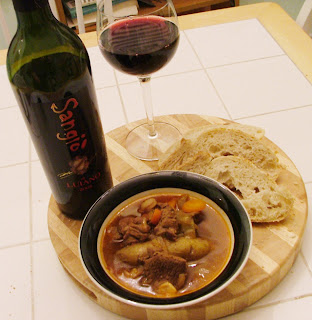 2002 Hill of Content "Benjamin's Blend" White. I drank this for the first Combinations challenge, though I purchased another bottle in anticipation of my birthday dinner. See, my name's Benjamin, and there's a guy riding a bike on the front, and when I was seven I fractured my skull in a bike accident, the last of several childhood head injuries. Whether or not any residual brain damage is present is up to my various friends and readers. I showed the bottle off at the party and Mom and Dad got a kick out of it, but we didn't get around to drinking it.
2002 Hill of Content "Benjamin's Blend" White. I drank this for the first Combinations challenge, though I purchased another bottle in anticipation of my birthday dinner. See, my name's Benjamin, and there's a guy riding a bike on the front, and when I was seven I fractured my skull in a bike accident, the last of several childhood head injuries. Whether or not any residual brain damage is present is up to my various friends and readers. I showed the bottle off at the party and Mom and Dad got a kick out of it, but we didn't get around to drinking it. Months later, I'm getting a lot of melon flavors. It's a lovely little white wine, and definitely good for salads, seafood courses, or even casual sipping before dinner. As a second note, I've been impressed with this and other selections from The Australian Premium Wine Collection. The wines all have a smaller label above the main one stating membership in this group.
I'd love to see similar marketing in the US. For instance, the "BBQ Collection", or "The Seafood Gourmet Collection", or any number of categories. I think one of the hardest things for novice wine drinkers in the US is getting away from the one or two wines he or she really likes. Such cross-winery marketing could be an interesting experiment, particularly if it focused on well made but not obscure wines.









